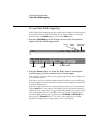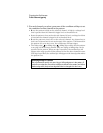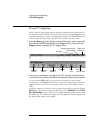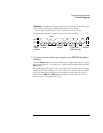
3-20
Triggering the Oscilloscope
To use CAN triggering
2Press the Baud softkey to set the CAN signal baud rate.
The CAN baud rate can be set to:
The default baud rate is 1 Mb/s
3Press the Trigger: softkey to select the trigger condition.
The SOF (Start of Frame) is th e only trigger condition available. The CAN trigger
will trigger on the Start of Frame bit of a Data frame, Remote Transfer Request
(RTR) frame, or an Overload frame.
4Press the Signal softkey to set the type and polarity of the CAN signal.
This also automatically sets the channel label for the source channel. The
channel shown in the Source softkey can be connected as follows:
Dominant high signal:
• CAN_H - the actual CAN_H differential bus signal.
Dominant low signals:
• CAN_L - the actual CAN_L differential bus signal.
• Rx - the Receive signal from the CAN bus transceiver.
• Tx - the Transmit signal to the CAN bus transceiver.
• Differential - the CAN differential bus signals connected to an analog
source channel using a differential probe.
5Press the Source softkey to select the channel connected to the CAN
signal line.
If the Signal softkey is set to Differential, connect an analog source channel to
the CAN differential bus signal using a differential probe.
As you press the Source softkey (or rotate the Entry knob on mixed-signal
oscilloscopes), the CAN label for the source channel is automatically set and the
channel you select is shown in the upper-right corner of the display next to
"CAN".
Adjust the trigger level for the selected analog channel by turning the Trigger
Level knob. Select Threshold in the D7 Thru D0 or D15 Thru D8 menu to set the
level for digital channels. The value of the trigger level or digital threshold is
displayed in the upper-right corner of the display.
10 kb/s 50 kb/s 125 kb/s 800 kb/s
20 kb/s 83.3 kb/s 250 kb/s 1 Mb/s
33.3 kb/s 100 kb/s 500 kb/s


















